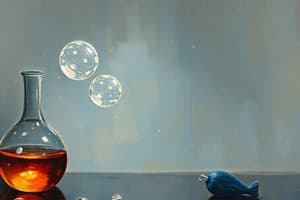Podcast
Questions and Answers
Explain the concept of extent of reaction in chemical engineering.
Explain the concept of extent of reaction in chemical engineering.
The extent of reaction represents the progress of a chemical reaction and is defined as the number of moles of reactant that have undergone reaction. It is denoted by ξ.
What is the mole balance equation for a continuously stirred tank reactor (CSTR)?
What is the mole balance equation for a continuously stirred tank reactor (CSTR)?
The mole balance equation for a CSTR is typically expressed as the rate of change of the number of moles in the reactor with respect to time, taking into account the flow of reactants and products in and out of the reactor.
Compare and contrast the use of extent of reaction and conversion in chemical reactor analysis.
Compare and contrast the use of extent of reaction and conversion in chemical reactor analysis.
Extent of reaction and conversion are both measures of the progress of a chemical reaction, but while extent of reaction is based on stoichiometry, conversion is a more general measure of the fraction of reactant that has been converted to product.
Discuss the application of Levenspiel plots in chemical reactor design.
Discuss the application of Levenspiel plots in chemical reactor design.
What are the key differences between batch reactors, plug flow reactors (PFR), and continuously stirred tank reactors (CSTR)?
What are the key differences between batch reactors, plug flow reactors (PFR), and continuously stirred tank reactors (CSTR)?
Flashcards are hidden until you start studying




